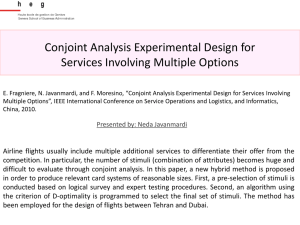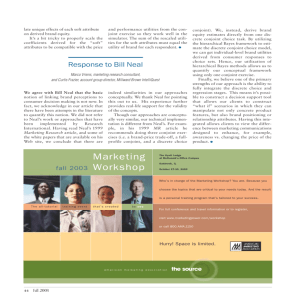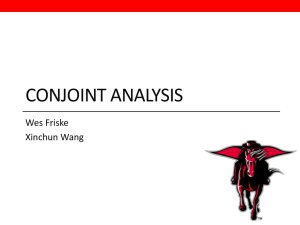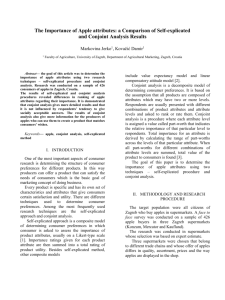Commercial Use of Conjoint Analysis in Europe
advertisement
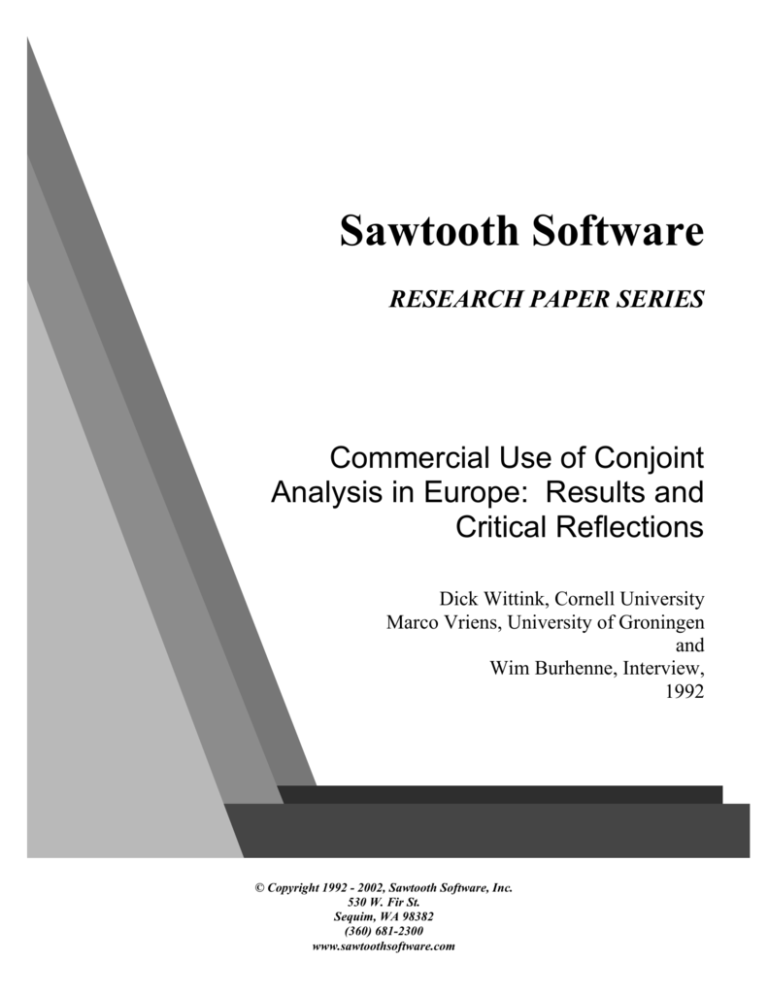
Sawtooth Software RESEARCH PAPER SERIES Commercial Use of Conjoint Analysis in Europe: Results and Critical Reflections Dick Wittink, Cornell University Marco Vriens, University of Groningen and Wim Burhenne, Interview, 1992 © Copyright 1992 - 2002, Sawtooth Software, Inc. 530 W. Fir St. Sequim, WA 98382 (360) 681-2300 www.sawtoothsoftware.com Commercial Use of Conjoint Analysis in Europe: Results and Critical Reflections Dick R. Wittink1 Marco Vriens2 Wim Burhenne3 Revised, July 1992 Copyright Sawtooth Software, 1996 1 Professor of Marketing and Quantitative Methods, Johnson Graduate School of Management, Cornell University, Ithaca, NY 14853, USA. 2Assistant Professor of Marketing Research, Faculty of Economics, University of Groningen, P.O. Box 800, 9700 AV Groningen, The Netherlands. 3Assistant Project Manager, Interview, P.O. Box 60068, 1005GB Amsterdam, The Netherlands; at the time the study reported here was carried out, student at the Faculty of Economics, University of Groningen. Support for the research reported in this paper was provided by NWO (the Netherlands Organization for Scientific Research) and through a gift to the Johnson School by Procter and Gamble. Abstract We report the incidence of conjoint analysis applications by European market research suppliers. Based on responses to a survey, we document about 1,000 commercial projects over a five-year period and show breakdowns by product category, study purpose, and other characteristics such as study design, data collection, and data analysis. The results are compared with information collected for an earlier time period in the United States. We also discuss recent conjoint research results, identify issues that warrant further study, and suggest how the current practice of conjoint analysis can be improved. 1. Introduction Conjoint analysis has, in a relatively short time, become a popular research tool for commercial applications. Green and Srinivasan (1978) provided a state-of-the-art review of the research activities and developments in this area. They proposed the term conjoint analysis for the work done in marketing, to distinguish it from the orientation in mathematical psychology toward testing the adequacy of respondents' data with respect to alternative information processing rules. An update of their review, with a discussion of new developments in conjoint analysis, appeared only recently (Green and Srinivasan 1990). Conjoint analysis has often been identified as a relevant method in the new-product development process. Mahajan and Wind (1991) reported results from a survey for which the largest group of respondents represented industrial goods. The respondents cited 24 different models and methods of which conjoint was the sixth most frequently used. User satisfaction was reported for the six top methods, and conjoint achieved the highest percent (55) stating high satisfaction and the lowest (0) stating low satisfaction. The primary usage reason for conjoint was "improves [new product] success rate"; this was cited by all respondents using conjoint. One limitation mentioned was the method's "inability to capture the complexity of the market". At a conference on roles for research and models in improving new product development, sponsored by the Marketing Science Institute, attendees representing industrial firms mentioned conjoint second (after focus groups) among models and methods used. Conjoint was said to be most useful " . . . in determining product design tradeoffs, setting marketing services and mix and doing competitive benchmarking" (Weinberg, 1990, p. 13). Thus, conjoint appears to receive high marks from managers, in comparison with other methods used in new-product development. The commercial use of conjoint analysis in the United States has been documented by Cattin and Wittink (1982) and Wittink and Cattin (1989). Cattin and Wittink obtained information from 17 firms which collectively had completed about 700 projects from 1971 through 1980. Almost three out of every four applications involved new product/concept identification as one of the purposes. Pricing and market segmentation were also frequently mentioned as reasons for conjoint projects. Wittink and Cattin provided an update of the earlier survey, based on 66 responding firms. For the period 1981 through 1985, they indicated that more than 1,000 projects were carried out by the respondents. They also compared various characteristics of the commercial projects with corresponding data on the first survey. These comparisons suggested that systematic changes in, for example, data collection and analysis procedures had taken place, during a period of substantial growth in the commercial use. The systematic changes were consistent with research results reported in the marketing literature. No systematic information is currently available on the extent and nature of the commercial use of conjoint analysis in Europe. We report results on such questions, using a modification of the survey instrument used by Wittink and Cattin. In the next section, we discuss the procedures used to contact potential suppliers of commercial conjoint analysis and the survey instrument. This is followed by a section in which the survey results are presented. The results for Europe1 are compared with the most recent results available for the United States. The comparisons are complicated by differences in the sources for the sampling frames, the time periods, and other factors. We interpret the findings in light of available theoretical and empirical research findings. The final section consists of our conclusions and recommendations. 2. Data Collection We defined the target population of interest as the market research agencies offering quantitative analyses to clients in Europe. The basis for the sampling frame used is the member directory of ESOMAR, the European Society for Opinion and Marketing Research, which includes about 560 firms. Only members identified in the 1990 directory as offering quantitative analyses were included in the frame. This resulted in a list of 481 market research agencies. To enhance the frame with agencies that may offer conjoint analysis as a service, but are not members of ESOMAR, we contacted three conjoint software suppliers: Bretton-Clark, Sawtooth Software, and Scott Smith. Unfortunately, only one of these three providers, Sawtooth Software, was willing to provide a (potential) client list, containing 72 addresses not included in the ESOMAR list. Thus, the sampling frame consisted of 553 European agencies, all of which received the survey instrument.2 This is about twice the number of firms contacted by Wittink and Cattin (1989) in the United States. The firms included in this frame are located in 23 different countries dominated by Germany (136 firms) and the United Kingdom (90 firms). We obtained 159 responses (29 percent) of the agencies contacted.3 This response rate also compares favorably with the overall rate of 24 percent obtained by Wittink and Cattin. Germany and the United Kingdom dominated the responding firms, with 37 and 31, respectively. Of the 159 respondents, 70 (44 percent) indicated they had used conjoint analysis, while 59 (37 percent) mentioned they had recently (within the last five years) used conjoint analysis for a client.4 Since the survey instrument was designed to obtain information about the commercial use of conjoint during the period July 1986 through June 1991, we present results based only on these 59 respondents. Again, the largest number of firms indicating recent commercial use are in Germany (19) and the United Kingdom (10). The survey instrument contained 33 questions, ranging from the year in which the firm started using conjoint analysis to the respondents' use of computer packages for conjoint analysis. Included in the survey were questions about the product categories for which conjoint analysis was used, the purposes of the projects, means and methods of data collection, estimation procedures, and other characteristics, as discussed below. 3. Survey Results The 59 firms, indicating the recent use of conjoint analysis for client projects, together carried out 956 projects during the five-year period. This may be compared with 698 documented applications for 17 firms by Cattin and Wittink (for the 1971 - 1980 period) and 1062 projects identified by Wittink and Cattin for 66 firms in the United States during 1981 - 1985. Thus, in both the United States for the period 1981-85 and in Europe during 1986-91 we have an average of approximately 16 projects per respondent or slightly more than three projects per year per respondent. Of the 59 European firms, only seven used conjoint analysis before 1980, 14 had started between 1980 and 1986, and the remaining 38 started during or after 1986. Although we do not know the number of firms that may have quit offering conjoint analysis prior to 1986, the diffusion of the use of conjoint in Europe may be especially strong during recent years. It is likely that the introduction of special computer software has greatly expanded the number of firms offering conjoint analysis as a commercial service, in both Europe and in the United States. The largest number of projects by country is obtained for Germany (348), followed by the United Kingdom (126). We provide an overview of the principal survey results, and show data from the most recent comparable survey in the United States in Table 1. Frequency of Usage by Product Category. The majority (54 percent) of the commercial applications documented by survey respondents in Europe during the period July 1986 through June 1991 involved consumer goods, as was true in the United States (59 percent) during the period January 1981 through December 1985. Industrial goods applications accounted for less than 20 percent of the applications in both surveys. The two service categories together accounted for 27 percent of the applications in Europe, whereas these represented only 18 percent in the United States. Conceivably, the latter difference is due more to the time difference than to systematic differences between the continents (or to sampling frame or responding firm differences). For example, it is well known that in both geographic areas service industries are experiencing substantially higher growth rates than manufacturing industries. The industry growth rate might be responsible for the larger percent of applications in services for the recent five-year period in Europe relative to the earlier period in the United States. Project Purpose. Respondents were asked to identify one or more purposes served by the conjoint analyses. We show in Table 1 that pricing was the single most frequently identified purpose in Europe, whereas in the United States it was third in frequency. Market segmentation also ranked higher in Europe, although the actual percent of market segmentation applications is slightly higher in the United States. Both the percentage and the ranking of competitive analysis are higher in the United States data. In fact, the percent of times competitive analysis was mentioned is only about half as often in Europe as in the United States. It suggests that the impact of changes in competitors' marketing activities on a given brand's market position is not nearly as often investigated in Europe, at least with conjoint analysis. Interestingly, on average the number of purposes identified equals about 1.5 in Europe but 2.0 in the United States. Whether this is due to a systematic difference in the focus of commercial projects or a difference in perceptions or tendencies to report is impossible to determine. We also note that the ordering of the "purpose" categories would show new product/concept identification with the highest percent, if the survey respondents are equally5 weighted (i.e., if the number of projects per respondent is ignored). This means that respondents with smaller numbers of projects are more likely to use conjoint for new products as the primary purpose, relative to respondents with larger numbers of projects. Means of Data Collection. In both Europe and the United States, the personal interview is the most frequently used means of data collection. However, the computer-interactive method popularized by ACA (Adaptive Conjoint Analysis, Johnson 1987) is a very close second in Europe. The dramatic difference in the percentage of projects using ACA between Europe and the United States is most likely primarily due to the fact that ACA was introduced in 1985. It is now, in the United States as well, a very heavily used software package (see e.g., Green et al. 1991a). The advantages of a computer-interactive method include the flexibility in tailoring questions to the respondent, and immediate availability of the data and results on the computer. The primary disadvantage is that the computer may not be suitable for certain audiences (e.g., older respondents). Stimulus Construction. We find that ACA is the most frequently (42 percent) used method in Europe. Full-profile is second (24 percent) and tradeoff matrix third (15 percent). This result differs substantially from the earlier results in the United States, where full-profile dominated. However, ACA was not available, except for the last couple of months during the 1981-85 period. It is interesting to see the substantial difference in the ratio of percentages for full-profile and tradeoff matrix designs between Europe and the United States. In Europe this ratio equals 1.6 (24/15), while in the earlier period in the United States it is 10.2 (61/6). The popularity of the tradeoff matrix approach in Europe is surprising, given that the developer has called the method obsolete. Indeed, in the U.S. only six percent of the applications were based on this method during a period when ACA just became available. About five years later the tradeoff matrix approach still accounts for fifteen percent of the applications in Europe. Stimulus Presentation. The vast majority (75 percent) of the applications involve verbal descriptions for the presentation of stimuli to respondents. Pictorial representations are second in frequency, but these are used only nine percent of the time. Of course, verbal descriptions are easier to use than pictures or prototypes of products. Also, ACA and tradeoff matrices, which together account for 57 percent of the applications, require verbal descriptions. It is useful to consider, nevertheless, how consumers approach the choice between alternatives in the marketplace. For example, many consumer durables are chosen by consumers based on an inspection of physical products available in a retail outlet. Such an inspection should be more closely approximated by pictorial representations. Response Scale. The survey results clearly establish that the rating scale is now the dominant measurement approach. This dominance is partly due to the heavy use of ACA, which incorporates preference intensity rating scales in its paired comparison section. Still, 22 percent of all conjoint applications are based on rank order data. This includes all tradeoff matrix applications, which account for 15 percent of the applications (see Table 1). Rank orders have been said to provide greater reliability (Green and Srinivasan 1978), although incontrovertible evidence in support of this statement is not available. Reasons for the trend toward rating scales, apart from its fixed use in ACA, may include the (implicit) belief that rating scales provide interval-scaled data. Thus, analysts may feel more comfortable about the use of standard regression analysis for the estimation of parameters with rating-scale data. Variable Definition. Preference intensity (used in ACA) and preference are the primary definitions used for the desired judgments in conjoint analysis. A proper definition for the judgments is an essential aspect of a conjoint study. We believe that it should be guided by the extent to which the variable relates to marketplace choices. Assuming that the reason for a conjoint study is to estimate how changes in product and marketing program characteristics that could be made influence marketplace choices, it is important to use a definition that allows for the best possible predictive validity of marketplace behavior, holding other variables constant. In this regard, we note that definitions such as liking and preference are quite appropriate, so long as respondents are made to understand that their judgments reflect their expected marketplace behavior. Estimation Procedure. A substantial amount of academic research has focused on the relative performance of alternative algorithms. Initially, researchers favored nonmetric estimation procedures such as MONANOVA and LINMAP for rank order data. However, simulation and empirical studies showed that OLS (Ordinary Least Squares) applied to rank order data provides comparable results (Green and Srinivasan 1978). Because OLS is easier to apply and commonly available, at least some researchers accepted the use of a metric procedure on nonmetric data. However, the dominant use of OLS in Europe (see Table 1) is directly linked to its use in ACA. Interestingly, MONANOVA and LINMAP together account for 22 percent of the applications, which is exactly the relative frequency with which rank order data are collected. Thus, it is unlikely that nonmetric procedures are applied to rating scale data in commercial conjoint studies in Europe. And there is no evidence that OLS is applied to rank order data in Europe, despite the research results referred to above. The results for the United States suggest, however, that OLS is applied to rank order data in some applications. Other Aspects. Apart from the characteristics of conjoint applications identified in Table 1, we also asked the firms questions regarding aspects such as sample size, data aggregation, predictive validity, preference (market) share analysis and software use. Briefly, the number of respondents (sample size) was reported to be as low as 30 and as high as 1,000 (with a mean of 268). With regard to data aggregation, respondents indicated a higher frequency for the use of prespecified segments (39 percent of the projects) than for clusters based on respondent similarity in judgments or in parameter estimates (24 percent of the projects). Of the 59 firms, 30 indicated they have used prespecified segments at least once, while 21 firms have used clustering at least once. The predictive validity of holdout judgments was examined in only nine percent of the projects. Market share analyses, based on simulated market scenarios, were used in 56 percent of the projects covered by our survey. Such analyses require explicit consideration of the link between how a respondent chooses between alternatives and the parameter estimates for a preference model. In most applications the parameter estimates are at best interval scaled. In that case, only the first-choice rule can be used in the share analyses. This rule awards the purchase to the item with the highest predicted preference out of all alternatives considered in a given market scenario. However, in ACA the final section of the data collection obtains a respondent's probability estimates of choosing each of a small number of objects. The link between these, presumably ratio-scaled, probabilities and the interval-scaled parameter estimates is then used to create ratio-scaled parameter estimates, separately for each respondent. In this manner, several other probabilistic choice rules can be considered in ACA for the market share analyses. This is especially advantageous for applications to frequently purchased items where the choice of a brand may vary systematically and/or randomly. An increasing number of software packages has become available for commercial applications of conjoint analysis, after their initial development in the 1980's. Much of the recent growth in the use of conjoint analysis, both in the United States and in Europe, may be attributable to the availability of software. The software used most frequently is provided by Sawtooth, SPSS and Bretton-Clark. We show that 30 of the 48 respondents from the ESOMAR list and 10 of the 11 respondents from the Sawtooth supplement identified software use. Interestingly, the percentages of respondents for the three software types are very similar for the two sources for the sampling frame. Sawtooth's ACA is by far the most popular with 67 percent of the 30 ESOMAR respondents and 80 percent of the Sawtooth respondents indicating use. (See Table 2) The recent availability of software is likely to have had considerable influence on the growth in the number of firms offering conjoint as a commercial service. The vast majority (36 firms) introduced conjoint analysis to its clients after the introduction of ACA (and other software) in 1985. Also, the average number of projects completed during the last five years tends to be highest for firms that started in the early and mid 1970's (innovators/early adopters) or in the mid 1980's. Firms introducing the method in the late 1970's or early 1980's carry out a relatively small average number of projects. 4. Discussion and Conclusions We find the incidence of commercial applications of conjoint analysis in Europe to be high. The vast majority of firms, having conducted applications during the most recent five years, started offering conjoint as a service after 1985. This coincides with the introduction of several new conjoint software programs into the marketplace. The popularity of ACA in Europe is striking, and its heavy use may be primarily responsible for the differences in the commercial practice between Europe and the United States reported here. Of course, ACA was barely available during the earlier period in which the data were collected in the United States. Additional differences between the two regions may occur due to systematic differences in the sampling frames. Green and Srinivasan (1990) suggest that the full-profile method should be preferred as long as the number of attributes included in a conjoint study is small (up to six). For a larger number of attributes, they recommend tradeoff matrices or bridging designs. Only for more than ten attributes do they suggest that ACA or other approaches may be preferred over full profiles. For a discussion of conceptual distinctions between ACA and full profile, see Huber et al. (1991). Our survey results do indicate that the application frequency of ACA increases as the number of attributes increases. However, ACA can outperform full-profile even when the number of attributes is less than ten. For both five and nine attributes, Huber et al. (1993) report higher predictive validity of holdout choices for ACA. In their study, all data including full-profile evaluations, were obtained via the computer. Given that ACA combines compositional (self-explicated data) and decompositional (preference intensities for one of two prespecified objects) approaches, one may ask how ACA compares to self-explicated data. Green and his associates (Agarwal and Green 1991; Green et al. 1991a) claim that ACA is inferior to an independent self-explicated procedure, using a task involving six attributes. However, the validity of these results is in doubt because all respondents performed the ACA task before the self-explicated task (and before the holdout task). Thus, it is impossible to rule out the hypothesis that the order in which the tasks were administered is responsible for their result (see also Johnson 1991). A similar question can be asked for the data obtained within ACA. Green and his associates (Green et al. 1991a; Green et al. l991b) suggest that the improvement in predictive validity due to the decompositional part is not very high. This improvement can be determined by comparing the validities for the final ACA solution and the initial (compositional only) ACA solution. However, the value of the contribution of the paired comparison section is difficult to determine if the upper limit on the predictive validity (i.e., the reliability of the holdout data) is not known. Wittink (1991) has criticized other evaluations of the paired comparison data in ACA made by Green et al. Separately, Huber et al. (1993) show that the final ACA solution provides significantly higher hit rates (of holdout choices) than the initial solution. Furthermore, this improvement covers about half the difference between the validity for the initial ACA solution and the maximum possible validity. They also suggest that multiple modes of data collection should be considered in conjoint analysis. For example, a weighted combination of the initial and final solutions from ACA and the full-profile solution outperforms the solution from any one method, in terms of both hit rates (individual predictions) and preference shares (aggregate predictions). Wittink et al. (1991) demonstrate that the final ACA solution provides significantly different part worths than the initial solution. Specifically, they find that the derived relative attribute importances based on the final solution differ systematically from comparable relative attribute importances constructed from the self-explicated data. Interestingly, they also suggest that the magnitude of the average difference in derived importances between the final and initial ACA solution is comparable to the average difference in derived importances between the full profile and the initial ACA solution. They also show that the number of (intermediate) levels, for attributes that are expected to have monotone utility functions, has a positive effect on derived importances. And the magnitude of this effect was found to be twice as large for full profile as for ACA. These empirical results tend to be in agreement with ACA being the preferred method for conjoint analysis in Europe. Still, the reasons for extensive use in Europe for this method may be the convenience of the software package as well as the possible superior performance. With regard to performance, we note that Van der Lans et al. (1992) show that constrained parameter estimation improves the predictive validity results and tends to reduce the difference in performance between ACA and full-profile. It also reduces the magnitude of the level effect such that on this aspect too the difference between ACA and full-profile is reduced, but not eliminated. Importantly, the study by Wittink et al. (1991) also indicates that the choice of the number of levels for a given attribute (holding the best and worst levels constant) can have a much greater impact on the substantive conclusions than the choice of a conjoint method. Researchers' interest has traditionally focused especially on the theoretical, conceptual, and empirical differences between methods. It appears that it would be useful to return to more fundamental questions that apply to all methods, such as the definition and choice of attributes and (number of) levels. Although verbal descriptions of stimuli represent by far the majority of applications, little is known about the possibility that systematic differences obtain between the results obtained from pictorial and verbal means. For example, attribute interaction effects may be more likely to occur with pictorial than verbal representations. Pictures have the advantage that more attributes can be meaningfully included in the full-profile method. Page and Rosenbaum (1987) report the results of a full-profile study using a combination of pictorial and verbal descriptions with twelve attributes. Research interest in analytical aspects related to conjoint analysis will probably continue to be high. Hagerty (1986) has developed criteria for OLS that can be used to choose between alternative models (for example, with or without interaction effects) for the optimization of expected individual-level or aggregate predictive validity. He shows that for individual-level predictions simple models (e.g. without interaction effects), and for aggregate-level predictions complex models (e.g. with interaction effects), tend to be best. In our survey, the majority of respondents acknowledge the importance of incorporating interaction effects. However, only about ten percent of the applications have allowed for interactions. Yet it is clear that for most commercial projects the concern should be with maximizing aggregate predictive validity. Krishnamurthi and Wittink (1991) have applied Hagerty's criteria to determine the improvement that can be made in overall performance (aggregate and individual) in case of idiosyncratic functional forms in the conjoint model. Their results indicate that the substantive conclusions and expected predictive validities can be improved if the functional form as well as the parameter estimates are individual-specific. Most conjoint applications allow for a maximum amount of respondent heterogeneity in parameter estimates. Yet, the segmentation of respondents can provide greater predictive validity. Prespecified segments are used frequently in the commercial applications in Europe. Whether these segments are meaningful depends on the availability of respondent characteristics, the relation between these characteristics and the preference function parameters (often as a set), and the ability of the analyst to anticipate this relation. Green and Krieger (1991) report poor results for prespecified segments. However, Montgomery and Wittink (1980) obtained, using only a few background variables with each one distinguishing parameters for a single attribute, predictive validities about half way between the validities for an aggregate model and respondent-specific parameter estimates. Clustering of respondents based on agreement in parameter estimates as a set between pairs of respondents resulted in roughly similar predictive validities as using prespecified segments. Clustering of parameter estimates has two important limitations: 1) substantial misclassification of respondents can occur due to unreliability of the estimated parameters; 2) algorithms typically do not optimize a measure such as the expected mean squared error of prediction (see Hagerty 1986). Procedures have been developed to alleviate one or both of these disadvantages (e.g. Wedel and Steenkamp 1989; DeSarbo et al. 1992). For a theoretical comparison and simulation results of different clustering methods designed to optimize a criterion function, see Vriens, Wedel, and Wilms (1992). With increasing use of rating scales for the response measure, and OLS for parameter estimation, we should ask whether ratings are truly interval scaled. If they are, the systematic effect on substantive conclusions that have been originally noted for ordinal data should either disappear or diminish in size. Currim et al. (1981) argued that the systematic effect on derived attribute importances due to the number of levels was consistent with constraints imposed on the results by rank order data. A subsequent experimental study based on five product categories showed that the magnitude of the effect was approximately equally large for rating scale and rank order data (Wittink et al. 1989). One interpretation of this result is that rating scale data may not be of (much) higher quality than rank orders. Thus, there is a need for research on the extent to which metric qualities obtain in rating scale data. Magnitude scaling is one option available to conjoint analysts for possible improvements in the preference judgments as well as for the determination of the metric quality of respondents' judgments. If rating scale judgments do have metric qualities, the level effect phenomenon observed for ratings would have to be due to other factors. Green and Srinivasan (1990) suggest that the effect occurs because respondents attend to attributes partly in reaction to the number of levels employed for each attribute in the design of the conjoint study. Wittink et al. (1992), however, were unable to find evidence in favor of such a psychological explanation of the level effect in ACA. They did obtain support for an algorithmic explanation. The latter result indicates that the level effect may be eliminated with suitable modifications in procedures. Thus, it would not be necessary to use equal numbers of levels for the attributes. With regard to stimulus presentation, we note that the use of pictures would appear to favor the full-profile method over other means of stimulus construction. For increased realism in pictorial representations, it should now be possible to have respondents evaluate hypothetical products created on a computer screen. We recommend that research studies be undertaken to determine: a) the feasibility of three-dimensional pictorial representations (see DeBont (1990) for a discussion of the potential benefits of using Computer-Aided Design (CAD) representations); b) the extent to which substantive conclusions differ between pictorial and verbal representations; and c) the difference in predictive validity of marketplace behavior between these methods. We conclude that conjoint analysis is receiving a great deal of attention and use in commercial market research in Europe. To stimulate further growth in the use of this method, researchers should identify opportunities and demonstrate advantages for modifications in the manner in which the method is applied. We believe that the opportunities are especially strong in the following areas: 1) the identification of application characteristics that require special approaches (such as pricing or market segmentation); 2) the use of design characteristics that resemble how consumers approach the marketplace choice task (such as with pictorial and CAD representations); 3) the resolution of systematic effects due to design characteristics such as the number of attribute levels; 4) the metric quality of rating scale and other (e.g. magnitude estimation) data; 5) the use of multiple modes of data collection from a given respondent; 6) allowance for interactions in the effects of attributes on preference or choice; and 7) the use of constrained parameter estimation. Footnotes 1. The firms reporting conjoint applications during the most recent five-year period are located in 15 different countries: Austria, Belgium, Cyprus, Denmark, Finland, France, Germany, Greece, Ireland, Italy, the Netherlands, Spain, Sweden, Switzerland, and the United Kingdom. No responses were received from firms located in Portugal and the (former) U.S.S.R. No recent applications were reported by responding firms located in Hungary, Luxemburg, Malta, Norway, Isjochoslavakia, and Yugoslavia. 2. The list supplied by Sawtooth is not restricted to the firm's clients. Rather, it contains addresses of all agencies and individuals who requested information on Sawtooth's conjoint software. Although the additional addresses allowed us to obtain a more comprehensive view of the commercial use of conjoint in Europe, specific characteristics of this use may be biased toward the features offered by Sawtooth. We believe that this possible bias is small. For example, of the respondents from the Sawtooth list 30 percent indicated they (also) use Bretton-Clark's software. For the ESOMAR list's respondents, only 13 percent said they use Bretton-Clark's software. 3. Each agency also received a separate form on which requests for information could be indicated. This was done, in part, to stimulate the contact persons to cooperate with the survey. We allowed for three types of requests: a) introductory material on conjoint; b) recent research papers on conjoint; c) a copy of the survey results. 4. Although we did not attempt to establish this, it seems fair to assume that of the 396 agencies not responding to the survey the vast majority has not offered conjoint analysis as a service. If none of these firms in fact did, 12 percent of the sampling frame would have used conjoint analysis and 10.5 percent used it during the last five years. 5. We only mention the results that obtain when respondents receive equal weights if the results differ dramatically from those shown in Table 1. Generally speaking, the weighted results are the primary ones of interest if we are interested in describing characteristics of conjoint projects. Table 1 Characteristics of Commercial Applications Percentage of Applicationsa Europe USA Product/Service Category Consumer goods industrial goods Financial services Other services Other July 86-June 91 54 17 14 13 2 Jan. 81- Dec. 85 59 18 9 9 5 Purposeb Pricing New product/concept identification Market segmentation Competitive analysis Repositioning Advertising Distribution 46 36 29 22 13 2 NAc 38 47 33 40 33 18 5 Means of Data Collection Personal interview Computer-interactive method ACA Telephone interview Mail questionnaire Combination 44 42 7 3 4 64 12 8 9 7 Stimulus Construction ACA-design Full profile Tradeoff matrix Paired comparison Combination Other (hybrid) 42 24 15 4 5 10 NAc 61 6 10 10 13 Stimulus presentationc Verbal description Pictorial representation Actual products or prototypes Paragraph description Combination 75 9 6 3 7 NA NA NA NA NA Table 1 (continued) Percentage of Applicationsa Europe USA July 86-June 91 Jan. 81- Dec. 85 Response scale Rating scale (including ACA) Rank order Paired choice Other 70 22 5 3 49 36 9 13 Variable definitionc Preference intensity (ACA) Preference Intention to buy Choice Liking Other 42 26 18 7 4 3 NA NA NA NA NA NA Estimation procedure Ordinary Least Squares (OLS) MONANOVA Logit LINMAP Other 59 15 7 7 12 54 11 11 6 18 a The results reported are weighted by the number of projects completed by each supplier. b A given study may involve multiple purposes, such that the percentages reported add up to more than 100. c This category or characteristic was not included in the survey instrument. Table 2 Software Use by Respondent Type Sampling Frame ESOMAR n = 481 Sawtooth n = 72 Total n = 553 Total number of respondents using conjoint 48 11 59 Number of respondents identifying specific software use 30 10 40 Percent of respondents using specific software Softwarea ACA 67% 80% SPSS 33% 20% Bretton-Clark 13% 30% aThe percentages add up to more than 100%, because more than one type of software can be used by a respondent. References Agarwal, M.K. and P.E. Green (1991), "Adaptive Conjoint Analysis versus Self-Explicated Models: Some Empirical Results," International Journal of Research in Marketing, 8 (June), 141-6. Cattin, P. and D.R. Wittink (1982), "Commercial Use of Conjoint Analysis: A Survey," Journal of Marketing, 46 (Summer), 44-53. Currim, I.S., C.B. Weinberg, and D.R. Wittink (1981), "Design of Subscription Programs for a Performing Arts Series," Journal of Consumer Research, 8 (June), 67-75. DeBont, C.J.P.M. (1990), "Using Computer-Aided Design in Concept Testing, Advanced Computer Techniques and the Collection of Market Research Data," Proceedings EMAC/ESOMAR Symposium on New Ways in Marketing and Marketing Research, October. DeSarbo, W.S., M. Wedel, M. Vriens and V. Ramaswamy (1992), "Latent Class Metric Conjoint Analysis," Marketing Letters, forthcoming. Green, P.E. and A.M. Krieger (1991), "Segmenting Markets with Conjoint Analysis," Journal of Marketing, 55 (October), 20-31. Green, P.E. and V. Srinivasan (1978), "Conjoint Analysis in Consumer Research: Issues and Outlook," Journal of Consumer Research, 5 (September) 103-23. Green, P.E. and V. Srinivasan (1990), "Conjoint Analysis in Marketing: New Developments with Implications for Research and Practice," Journal of Marketing, 54 (October), 3-19. Green, P.E., A.M. Krieger and M.K. Agarwal (1991a), "Adaptive Conjoint Analysis: Some Cautions and Caveats," Journal of Marketing Research, 28 (May), 215-22. Green, P.E., C.M. Schaffer, and K.M. Patterson (1991b), "A Validation Study of Sawtooth Software's Adaptive Conjoint Analysis," 1991 Sawtooth Conference Proceedings, Ketchum, ID: Sawtooth Software, 303-14. Hagerty, M.R. (1986), "The Cost of Simplifying Preference Models," Marketing Science, 5 (Fall), 298319. Huber, J.C., D.R. Wittink, J.A. Fiedler, and R.L. Miller (1993), "The Effectiveness of Alternative Preference Elicitation Procedures in Predicting Choice," Journal of Marketing Research, 30 (February), forthcoming. Johnson, R.M. (1987), "Adaptive Conjoint Analysis," 1987 Sawtooth Software Conference Proceedings, Ketchum, ID: Sawtooth Software, 253-65. Johnson, R.M. (1991), "Comment on 'Adaptive Conjoint Analysis: Some Caveats and Suggestions'," Journal of Marketing Research, 28 (May), 223-5. Krishnamurthi, L. and D.R. Wittink, (1991), "The Value of Idiosyncratic Functional Forms in Conjoint Analysis," International Journal of Research in Marketing, 8 November, 301-13. Mahajan, Vijay and Jerry Wind (1991), "New Product Models: Practice, Shortcomings, and Desired Improvements," Report No. 91-125, Marketing Science Institute, Cambridge, Massachusetts. Montgomery, D.B. and D.R. Wittink (1980), "The Predictive Validity of Conjoint Analysis for Alternative Aggregation Schemes," in D.B. Montgomery and D.R. Wittink (eds.), Market Measurement and Analysis, Marketing Science Institute, Cambridge, Massachusetts, 298309. Page, A.L. and H.F. Rosenbaum (1987), "Redesigning Product Lines with Conjoint Analysis: How Sunbeam Does It," Journal of Product Innovation Management, 4 (June), 120-37. Van der Lans, I.A., D.R. Wittink, J.C. Huber, and M. Vriens (1992), "Within- and Across-Attribute Constraints in Conjoint Analysis for ACA and Full Profile," 1992 Sawtooth Conference Proceedings, Ketchum, ID: Sawtooth Software, forthcoming. Vriens, M., M. Wedel and T. Wilms (1992), "Simultaneous Segmentation and Estimation in Conjoint Models: A Monte Carlo Comparison of Recently Proposed Methods," working paper, Faculty of Economics, University of Groningen. Wedel, M. and J.B. Steenkamp (1989), "Fuzzy Clusterwise Regression Approach to Benefit Segmentation," International Journal of Research in Marketing 6, 241-58. Weinberg, Bruce D. (1990), "Roles for Research and Models in Improving New Product Development," Report No. 90-120, Marketing Science Institute, Cambridge, Massachusetts. Wittink, D.R. (1991), "Comment on Green, Schaffer and Patterson," 1991 Sawtooth Conference Proceedings, Ketchum, ID: Sawtooth Software, 315-23. Wittink, D.R. and P. Cattin (1989), "Commercial Use of Conjoint Analysis: An Update," Journal of Marketing, 53 (July) 91-6. Wittink, D.R., L. Krishnamurthi, and D.J. Reibstein (1989), "The Effect of Differences in the Number of Attribute Levels on Conjoint Results," Marketing Letters, 1 (2), 113-23. Wittink, D.R., J.C. Huber, J.A. Fiedler, and R.L. Miller (1991), "The Magnitude of and an Explanation/Solution for the Number of Levels Effects in Conjoint Analysis," working paper, Cornell University, November. Wittink, D.R., J.C. Huber, P. Zandan, and R.M. Johnson (1992), "The Number of Levels Effect in Conjoint: Where Does It Come From, and Can It Be Eliminated?," 1992 Sawtooth Conference Proceedings," Ketchum, ID: Sawtooth Software, forthcoming.
